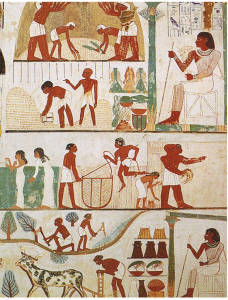
By Rabbi Ari Enkin, rabbinic director, United with Israel
One reason that God found the Jewish people worthy of redemption from Egypt was that they maintained their modest way of dress within a loose, immoral society.
The Midrash (Rabbinic literature) teaches that us that one of the reasons that God found the Jewish people worthy of redemption from Egypt was that they maintained their traditional manner of dress, even in the loose, immoral and immodest Egyptian suroundings. This is the primary feature that kept the Jewish people separate and distinct. Indeed, clothing is the most immediate and primary manner in which one can demonstrate his or her personality and religious beliefs.
In this article we will see how the ancient Egyptians, and the Jews who lived among them, used to dress.
Era of ‘The New Kingdom’
According to the Jewish Time Line Encyclopedia, the era of the Jews in Egypt was circa 1523 BCE, a period known as “The New Kingdom.” Do you know what the Egyptians were wearing in this New Kingdom? I’ll tell you: Very little.
Egypt is a hot country, and therefore, layers of clothing would have been unnecessary. The ancient Egyptians took advantage of this freedom and wore as little as possible. Their attitude was based on two factors: the heat and their poor sense of modesty. As such, what they wore was almost always light and airy. With the rise of the New Kingdom, Egyptian clothing, especially women’s clothing, became even skimpier.
Men generally wore nothing more than sandals and kilts, and often, nothing at all. The ruling class, however, wore tunics, cloaks or robes. Women, who mostly stayed indoors, also wore very little clothing. It is interesting to note that Egyptian women were very interested in jewelry, cosmetics, hygiene and skin care.

Clothing in ancient Egypt. (Photo: Wikimedia)
From all of the above, we see that the manner of dress in ancient Egypt was very immodest, even by today’s standards. Their manner of dress was certainly a major factor that contributed to their infamous sexual immorality and infidelity. Our sages tell us that during the “Plague of the Firstborn,” there was often more than one person in every home who died. How was this possible? How could there have been more than one firstborn? The answer, we are told, is that the rampant infidelity created many more “firstborns.”
This is the society to which the Jewish people immigrated and became enslaved. It was in Egypt that they formed their national identity. Nevertheless, they were not influenced by their surroundings and they maintained their Jewish customs and traditions, especially in the manner in which they dressed – indeed, they observed the Jewish dress code of tzniut (modesty).
Certainly we do not know the exact fashions or styles that the Jews in Egypt wore, but we can be sure that it was not the clothing commonly worn by the Egyptians. This was yet another way for the Egyptians to recognize who was Jewish, and by extension, who was to be enslaved.
According to Jewish law, women should dress in a manner that does not attract sexual attention to themselves. For instance, their legs, at least from the knees up, should be covered. So, too, they should ensure that their chests and upper arms are covered. Men as well are expected to dress in a dignified manner. For example, it is considered inappropriate to be bare-chested, and most authorities frown upon tank tops.
Perhaps we would all be well advised to live by the words of famous American fashion designer Rachel Zoe, who once said: “Style is a way to say who you are without having to speak.”
